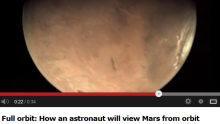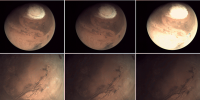The challenge of returning VMC to service
The anomaly at the end of summer 2011 caused glitches in the mass memory of the spacecraft to occur randomly. While these were infrequent enough not be a problem for data storage, they caused major problems for command storage, which are also kept on the mass memory. Therefore, over a period of several months following the anomaly, the FAST operations concept was developed by the Mars Express team (you can read more about the anomaly and the way in which the FAST concept works in the Mars Express blog).
One of the building blocks of the FAST concept was a dramatic reduction in the number of commands required to execute any operation on the spacecraft. This was largely done by creating On-Board Control Procedures (OBCPs) – small ‘macros’ (bits of computer code) that encapsulated several commands in a procedure that could, in turn, be triggered by just one command.
This was relatively straightforward for most of the spacecraft instruments because once they have been turned on and given initial instructions, they are intelligent enough to conduct most of their operations on their own. Unfortunately this is not the case for VMC; it’s a very simple (and lonely – Ed.) webcam and everything it does requires multiple commands to lead it through an observation, step-by-step.
Think of it like the difference between a digital camera and a webcam on your PC — you can use a digital camera independently from your computer and just download the pictures at the end, but a webcam needs to be constantly connected to your computer in order to work.
This meant that VMC observations could not easily be restarted; the number of commands needed was simply too high under the new on-board operating concept.
For example, prior to last year’s anomaly, a typical observation of 40 pictures would take 99 telecommands. After the anomaly, we could only afford 87. These 87 also needed to include the commands to point the spacecraft at Mars so VMC could see the planet.
With this limitation, VMC operations could not continue and no simple OBCP could replace the commands because each observation is different (different number of pictures, different exposures, etc.).
Therefore, the Mars Express team at ESOC started work on designing one of the most complex OBCPs used to date on the spacecraft — one that could completely manage a VMC observation. With our focus properly set on restoring our prime science mission, this time-available activity took some time, and then had to be carefully tested to ensure that it was safe both for VMC and for the spacecraft.
We finally completed the OBCP and sent it to the spacecraft on 4 May. We can now run a VMC observation with just two commands(!) — one to start the OBCP to manage the observation, and one to start another OBCP that safely shuts down the observation.
The first command contains all the parameters we need to specify how many images, their spacing, exposure and so on. This means that we’re now well within our command budget and it’s looking good for a full return to VMC operations.
6 May observation
The first observation using our new OBCPs to command VMC was a test observation — with just 8 images being captured — to demonstrate that the OBCP really worked and to assess its performance. The images captured were nevertheless the same beautiful views of Mars that we’ve come to expect from VMC. At the time the pictures were taken Mars Express was high above the North Pole of Mars, at a distance from Mars of around 10,000 km.
Mars went through its summer solstice at the end of March and so Northern summer on the planet was still in full swing at the time the pictures were taken (click for more on Mars seasons). Our picture shows this beautifully, with the bright white North Pole of Mars (called the Planum Boreum) shining in the sunlight.
We’ve rotated the image to put the North Pole pointing ‘up’.
Just as with the midnight sun here on Earth in the Arctic Circle, Planum Boreum is currently enjoying permanent sunlight itself and you can see the line between light and dark, the terminator, lying diagonally across the planet with the whole Northern hemisphere enjoying long summer days, while in the South the pole is in permanent darkness. We’ll see this change over the coming Martian year, you can watch it yourself in the VMC pictures – so stay tuned!
Future for VMC
The 6 May images were the first of a recommissioning campaign for VMC lasting for at least four observations. During these observations we will test the camera to check that its long period of downtime has not affected its performance. We will also put our new OBCP through its paces and test its performance and reliability. Once these tests are complete, we can declare that VMC is once again fully operational and resume full service with the camera. At this point we’ll also resume uploading all the images and data to the blog for you to see.
We are also planning to move to a new blog system soon (You’re reading it now! – Ed.) which should give a much more user-friendly way for you to monitor what VMC is up to and browse our images and raw data. We’re still looking at how best to use it to present VMC images but our aim will be the same — to provide you with the chance to see images as soon as they arrive from Mars and to get the full raw data so you can play with the sets and send us back your results. As ever, we look forward to seeing what you come up with and would love to post them back here on the website.
Cheers,
— Thomas Ormston
MARS EXPRESS Spacecraft Operations Engineer



Discussion: no comments